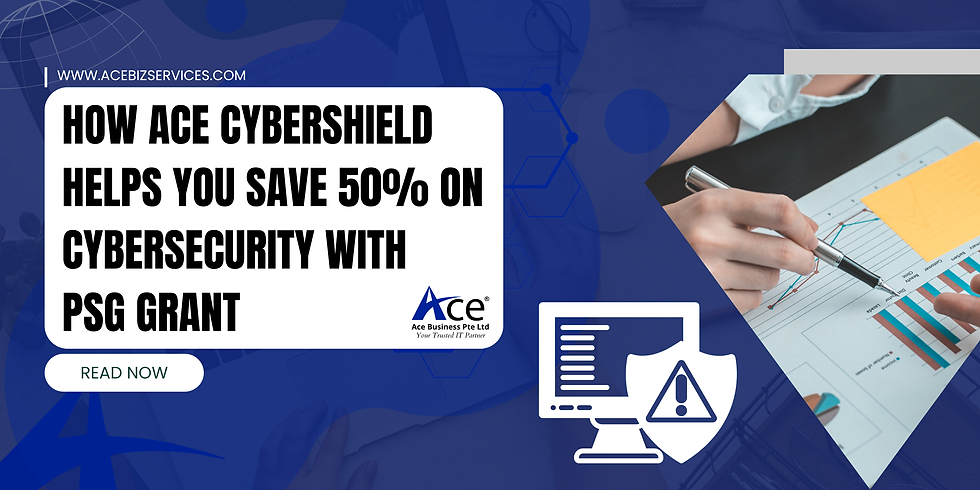5 Effective Ways to Prevent Data Breaches
- ACE Team
- Dec 27, 2021
- 3 min read
In this blog, we share five effective ways how to prevent data breaches with proven methods for prevention.

Asset Inventory
A clear picture of the hardware and software assets in your network and physical infrastructure will help you better understand your organization's security posture. An asset inventory can also be used to create categories and ratings for threats and vulnerabilities that your assets may face. Categories and ratings for these vulnerabilities can assist you in better prioritizing the remediation efforts that will be undertaken on these assets.
Endpoint protection is becoming increasingly important as a result of data breaches. Antivirus software alone will not prevent a major data breach. In fact, relying solely on anti-virus protection leaves your endpoints, such as desktops and laptops, vulnerable. Your desktops and laptops can serve as a major entry point for breaches.
A comprehensive endpoint solution will use encryption to prevent data loss and leakage, as well as enforcing unified data protection policies across all of your servers, networks, and endpoints, lowering the risk of a data breach.
Vulnerability and Compliance Management
Using a vulnerability and compliance management (VCM) tool, or at the very least performing a vulnerability assessment, will assist you in identifying gaps, weaknesses, and security misconfigurations in your physical and virtual environments. VCM can continuously monitor your infrastructure and IT assets for vulnerabilities, compliance flaws, and best practices in configuration.
Some of the benefits that will help mitigate a data breach include allowing your security team to better understand the environment's security vulnerability risks, i.e. Threat Landscape, and priorities for what needs to be remedied. A good VCM will enable you to develop an action plan to address these vulnerabilities and assign them to the appropriate staff members.
Regular Audits on Security Posture
Regular audits will aid in validating your security posture by identifying potential new gaps in compliance or governance. In comparison to vulnerability assessment or penetration testing, a security audit will provide a more thorough assessment of your security policies. A security audit takes into account the organization's dynamic nature as well as how the organization handles information security.
Common questions that may come up during a security audit include:
Is your company's information security policy documented?
Do you have a management process, escalation profiles, and procedures documented and tracked, as well as a playbook in place in the event of an incident or breach?
Do you have network security mechanisms in place (such as next-generation firewalls, IDS/IPS, EPP, and so on)?
Have you set up security and log monitoring?
Are there encryption and password policies in place?
Are a Disaster Recovery and Business Continuity Plan in place?
Is it possible to test applications for security flaws?
Is a change management process in place at all levels of the IT environment?
How are files and media stored? Who will have access to this backup? Are the restoration procedures tested?
Are the auditing logs scrutinized? When are the auditing logs for security reviewed?
Train & Educate Your Staff
After you have completed your security policy audits, you can implement a written employee policy regarding data privacy and security. You should hold regular security training to ensure that all employees are aware of the newly implemented policies – after all, people cannot voluntarily comply with unfamiliar policies. When developing your employee security policy, you should consider training on the following topics:
Controlling end-user access and privileges in accordance with the "least privilege" policy
The use of various, unique passwords on computers or other work-related devices.
Establish a documented system for terminating employees and vendors/contractors (passwords, key cards, laptop access, etc.)
Instruct employees on the importance of reporting suspicious data security leaks or breaches.
Make a policy outlining how employees should handle, dispose of, retrieve, and send data.
Employees must also be educated on the various types of modern phishing attacks. As we discussed in our ransomware blog, the most common way for ransomware to spread within an organization is through phishing. Your organization will be well served if you can train and educate your employees about the pitfalls and indicators to look for in a "phishy" looking email.
You should also consider appointing an ambassador within your organization to lead and oversee the completion of these various information security training topics.
Preventing data breaches may appear to be a time-consuming task. You will be in a much better position if you take a layered approach to security with various measures, policies, and procedures to mitigate security threats than if you allow your organization to remain slack in the face of an ever-changing threat landscape.
Need help in preventing Data Breached? Call us at +65 6262 0402 or email us at care@acebizservices.com to get the information details on your needs.











Comments